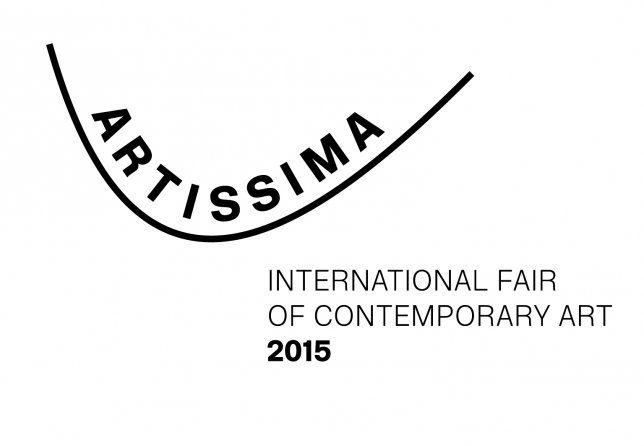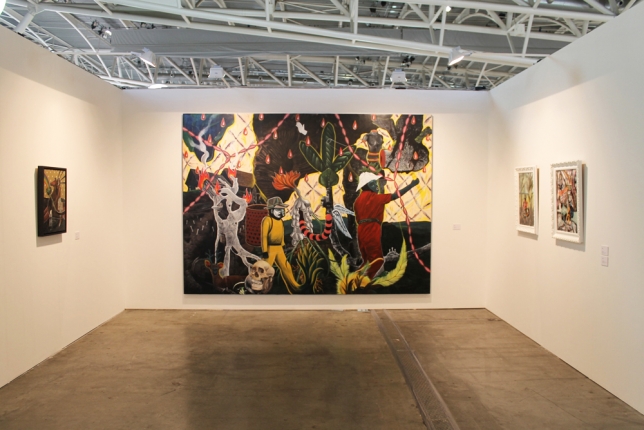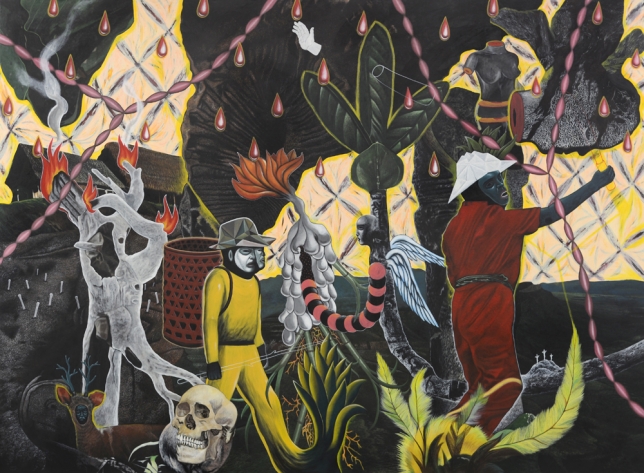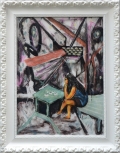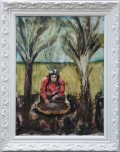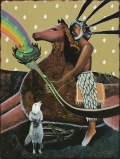RODEL TAPAYA | ARTISSIMA | November 6 - 8, 2015
ARNDT is pleased to announce its participation at ARTISSIMA 2015, with a solo presentation of work by RODEL TAPAYA. We look forward to welcoming you to our booth PF 7 in the PRESENT FUTURE section.
November 6, 2015 | 12 - 8 pm
November 7, 2015 | 12 - 8 pm
November 8, 2015 | 12 - 8 pm
Rodel Tapaya’s paintings, which are replete with symbolism and characters derived from Filipino folklore, invoke the mythical qualities of storytelling and the dense layer of meanings that can be found in legends. One of his large-scale paintings, “The Sacrificial Lamb,” channels through his native Philippine setting an old story about sin, ransom, and redemption—a tale that harks back to its Biblical origins, from the time of Abraham offering his son to a God up until when Romans had let a Jew sacrifice himself unto the cross.
In this particular narration, two brothers—Galgaran and Boaran, are downhearted to learn that their vast land, which had gone barren through a clearing by fire (a kaingin), would not bear crops. The brothers then have decided to spare their younger sister, whom they loved so much, from an impending famine by causing her own death. They encounter an angel to hear their predicament, and an old man who instructed them the virtues of sacrifice: of chopping their sister’s flesh and burying them into the ground to make the land fertile once again. This myth shrouds the painting with its symbols: fire from the Kaingin, the two brothers surveying the land, the amputated body of a woman which signifies the Sacrifice, the layers of buried bones and a canopy of innards that symbolize the flesh along with droplets of blood, suggesting the age-old promise of redemption through violence and sacrifice; and how there would always be the ‘innocents’ who will pay for their forebears’ sins. The crosses at Mount Calvary appear as a symbol, sprouting from a budding plant. The lamb appears with an old man’s face, embellished with antlers, a grotesque figure who embodies both the innocent and the wise who might have foretold the need for an offering to the weary brothers through its voice:
“Go on, and kill your sister. But, then, chop her flesh. You should take care not to waste her bones and keep her head intact. You broadcast her chopped flesh all over the kaingin (barren land) and plant her bones on its sides. Then, bury her head in the middle and build a hut that will serve as its shelter. Within three days you will find your sister in the hut and your land will be growing palays (rice crops), coconut trees, sugar canes, gabi and camote (sweet potatoes).”
This passage typifies Filipino folklore and legends. The same kind of legend that goes with Tapaya’s other works: a pair of small under-glass paintings, which are heated to form a three-dimensional shape around the painted image. Glass paintings are traditional artefacts during the Spanish colonial period in the Philippines. They usually depict religious themes. In these paintings called ‘Noontime Sorting’ and ‘Deep Thoughts,’ Tapaya recounts the legend of the origins of the Pineapple fruit instead, as told through a local folktale in the islands of Iloilo, Philippines. The story speaks of a girl beset by her idleness, immortalized at the moment when her ailing mother had asked her to cook rice, which through her indolence, was served burnt while the ladle for cooking went missing. It is at this moment, through her mother’s curse, she became a pineapple, when she wished for her “to have many eyes (a reference to the fruit’s layer of brown spots) so that (she) can find at once what she’s looking for.”
Rodel Tapaya paints the salient passages from these folklores and transform them into symbolic scenes: the two brothers’ dilemma in ‘The Sacrificial Lamb,’ as well as the girl’s idle and disgruntled state before turning into a legend’s fruit in ‘Deep Thoughts’ and ‘Noontime Sorting.’ These scenes, through Rodel Tapaya’s vision, goes through a revitalization of old tales, which is eventually combined with the present. The layers of symbols and the rich source of narrative elements combine for a kind of epic storytelling in painting—the kind which is abundant in meaning and allegorical references, the kind which acts as a preamble to society’s present conditions, and the kind which is deeply embedded within the voices and imagination of the past.
-Cocoy Lumbao
CV
Selected solo exhibitions and art fairs include: Rodel Tapaya at Art Basel Hong Kong (2015), "ICA Off-Site: Hong Kongese" (2015), curated by Gregor Muir, Alia Al-Senussi and Abdullah AlTurki at Duddell’s Hong Kong, Rodel Tapaya at Art Stage Singapore (2015), Rodel Tapaya at the Art Fair Philippines (2014), "Bato-Balani" at the Ateneo Art Gallery, Quezon City, Philippines (2014), "Cloudland" at the Art Hongkong, Hongkong (2012), "Prism and Parallelism" at the BENCAB Museum, Baguio City, Philippines (2012), "Flowers of the Tongue" at the Vargas Museum, UP Campus Diliman, Quezon City, Philippines (2010) and "Mythical Roots" at the SOKA ART Center, Beijing (2009). Selected group exhibitions are: "Bisa: Potent Presences" at the Metropolitan Museum of Manila, Philippines (2011) and "Thrice Upon a Time: A Century of Story in the Art of the Philippines" at the Singapore Art Museum, Singapore (2009).
PRESS
Artissima Live | Present Future: Interview with Fatos Üstek | 7 November 2015
ATP Diary | Present Future: Interview with Fatos Üstek | 7 November 2015
